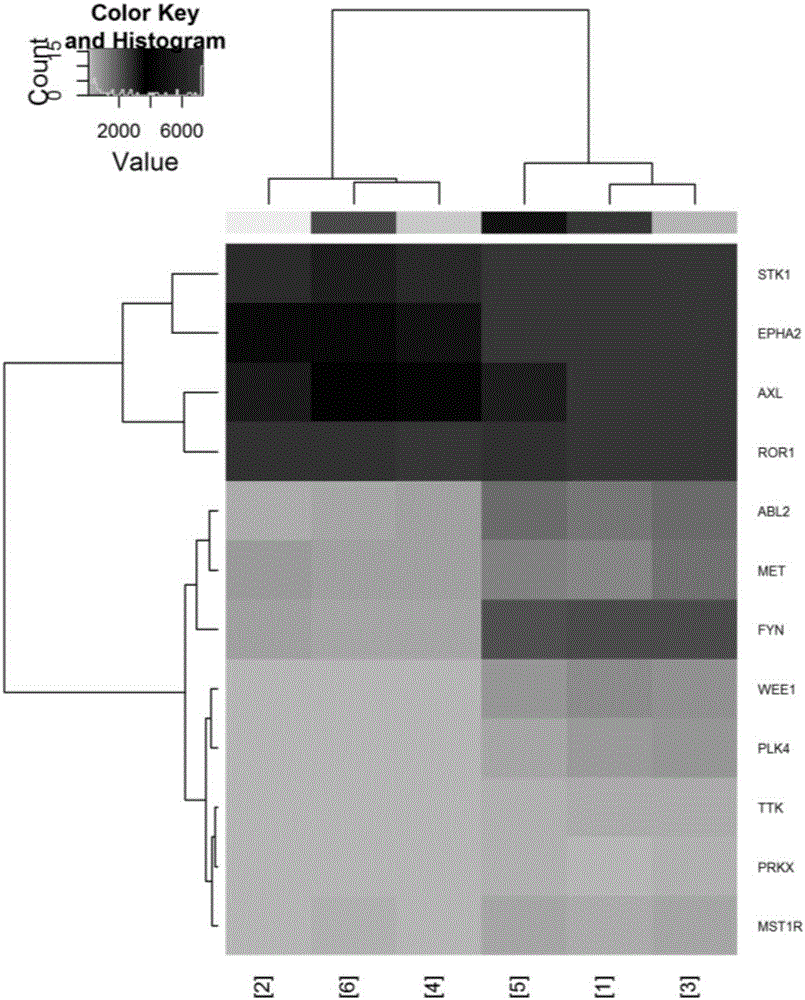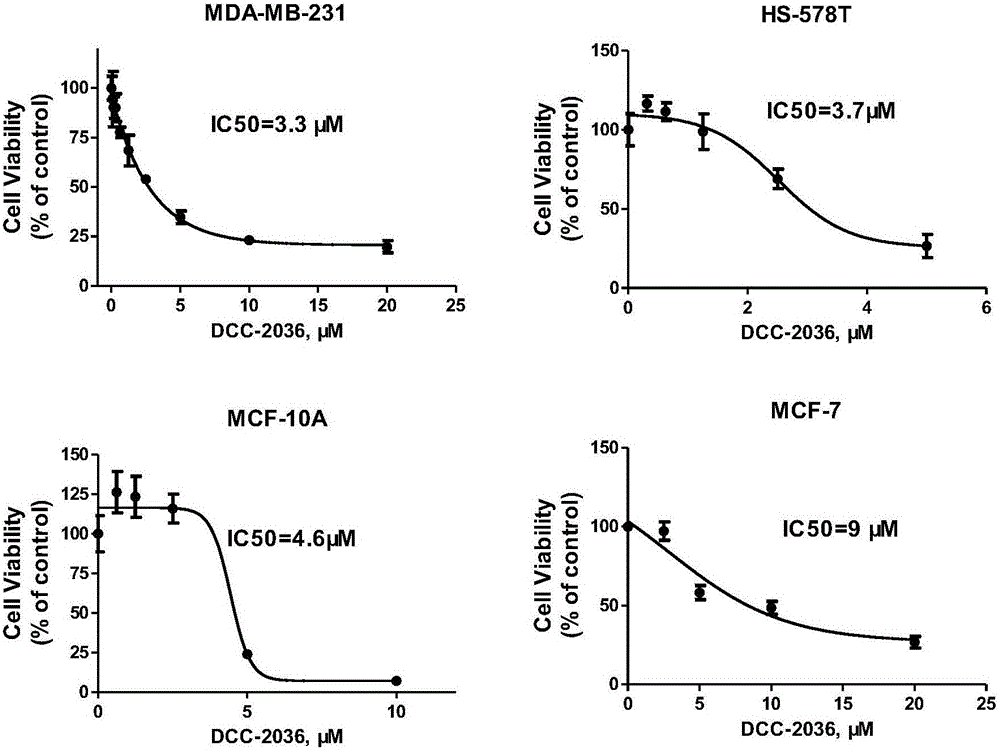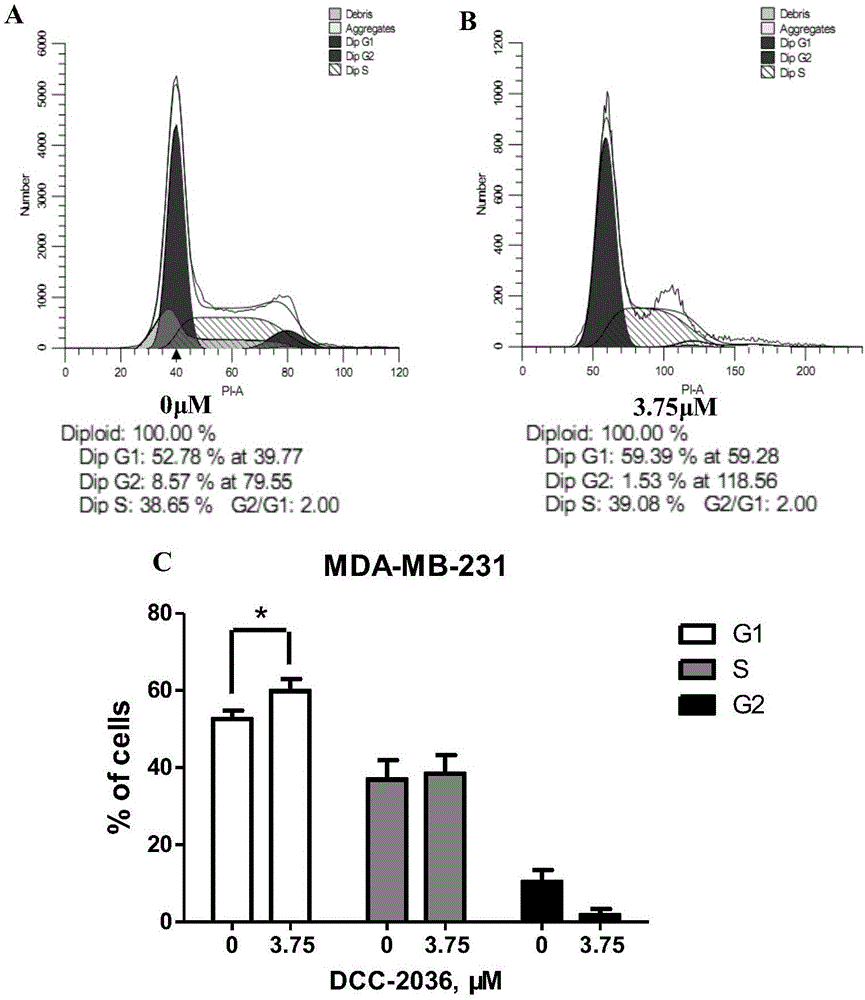Novel application of tyrosine kinase inhibitor DCC-2036
A technology of DCC-2036 and tyrosine kinase, which can be used in drug combinations, anti-tumor drugs, etc., and can solve problems such as triple-negative breast cancer that has not been seen
- Summary
- Abstract
- Description
- Claims
- Application Information
AI Technical Summary
Problems solved by technology
Method used
Image
Examples
Embodiment 1
[0040] Example 1: Effect of DCC-2036 on proliferation of triple-negative breast cancer cell lines MDA-MB-231 and HS-578T
[0041] The MTS method was used to observe the effect of DCC-2036 on the proliferation of TNBC cell lines at the cellular level. PR+, HER2-) breast cancer cell line MCF-7 and basal / triple-negative breast non-tumor epithelial cell line MCF-10A were seeded in 96-well plates, 3×10 per well 3 cells. After 24 hours, the cells adhered to the wall, and a blank group (only culture medium was added), a control group and a drug series group were set up, and three replicate wells were set up in each group, and the volume of each well was 100 μL. The culture was terminated at 72 hours. 4 hours before terminating the culture, add 20 μL / well of MTS / PMS. Continue culturing for 4 hours, and read the absorbance value (A value) at 490 nm with a microplate reader. Calculate the cell viability (Cell Viability) according to the following formula, cell viability=(A value of ...
Embodiment 2
[0046] Example 2 Effect of DCC-2036 on cell cycle distribution
[0047]TNBC cells (MDA-MB-231) were treated with different concentrations (0 μM and 3.75 μM) of DCC-2036 for 30 hours, then digested with trypsin to collect the cells, washed twice with PBS, discarded the supernatant, and added 1ml of 70% pre-cooled ethanol medium, blow and beat evenly, and fix at 4°C for more than 12 hours. Wash with PBS twice to remove ethanol, resuspend the cells in 0.5ml PBS after centrifugation, add propidium iodide (PI) and RNaseA to a final concentration of 50g / ml, incubate at 37°C for 30 minutes, and measure the cell cycle distribution by flow cytometry. see results figure 2 .
[0048] figure 2 The results showed that DCC-2036 could induce G1 arrest in MDA-MB-231 cells. 3.75μM DCC-2036 treatment of MDA-MB-231 cells for 30 hours increased the G1 phase of the cells.
Embodiment 3
[0049] Example 3: Effect of DCC-2036 on apoptosis of TNBC cell lines
[0050] The effects of different concentrations of DCC-2036 on the apoptosis of TNBC cell lines were detected by AnnexinV-FITC / PI double-staining flow cytometric detection technology. The specific method is: TNBC cell line MDA-MB-231 cells, HS-578T cells and Luminal A subtype cell line MCF-7 cells were treated with DCC-2036 at concentrations of 0 μM, 2.5 μM, 3.75 μM, and 5 μM (and 10 μM) respectively. After 24 hours, digest and collect cells, wash with 1×Binding buffer, add Annexin V-FITC dye and incubate for 20 minutes in the dark. PI dye was added before detection on the flow cytometer. The apoptosis rate of cells was evaluated by FACS Calibur flow cytometer and CellQuest Pro software (Becton Dickinson), the results are shown in Figure 3-5 .
[0051] Figure 3-5 The results show that DCC-2036 can induce the apoptosis of TNBC cell lines MDA-MB-231, HS-578T and Luminal A subtype cell line MCF-7 in a dos...
PUM
 Login to View More
Login to View More Abstract
Description
Claims
Application Information
 Login to View More
Login to View More - R&D
- Intellectual Property
- Life Sciences
- Materials
- Tech Scout
- Unparalleled Data Quality
- Higher Quality Content
- 60% Fewer Hallucinations
Browse by: Latest US Patents, China's latest patents, Technical Efficacy Thesaurus, Application Domain, Technology Topic, Popular Technical Reports.
© 2025 PatSnap. All rights reserved.Legal|Privacy policy|Modern Slavery Act Transparency Statement|Sitemap|About US| Contact US: help@patsnap.com



